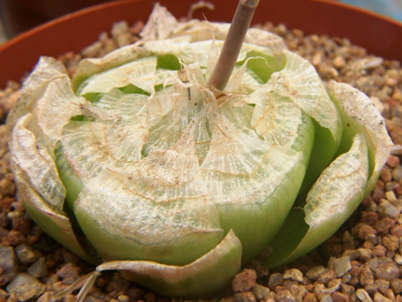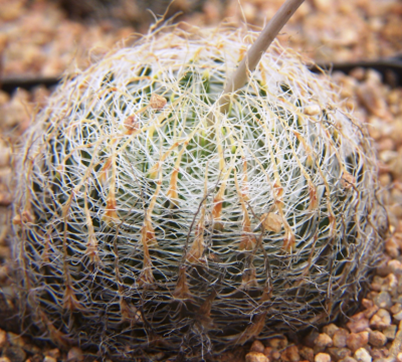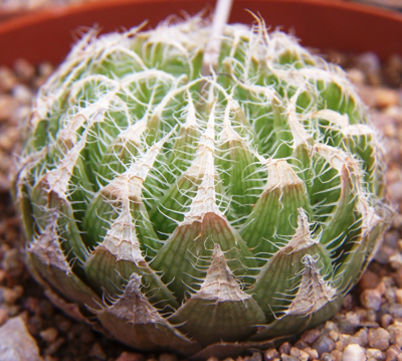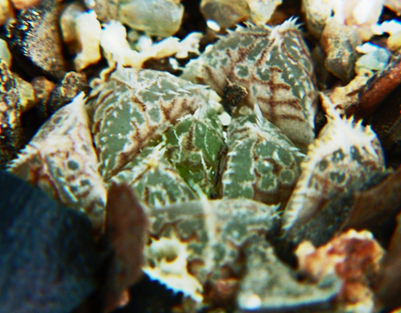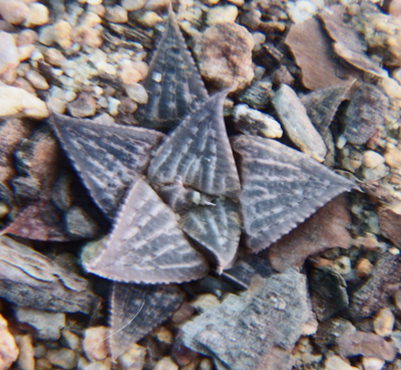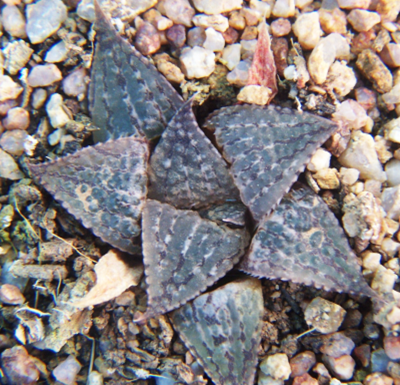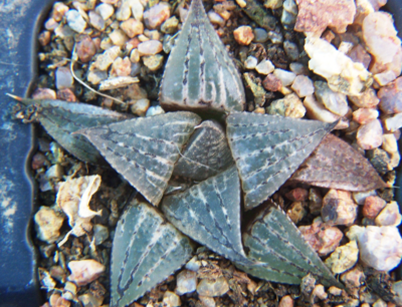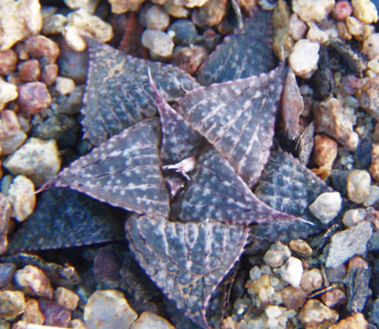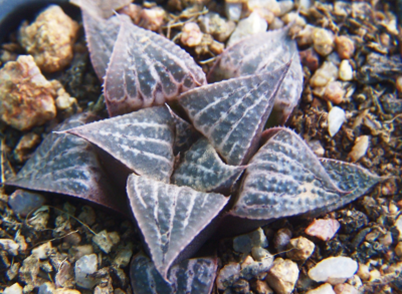16. Haworthia lockwoodii Archibald, Flower.Pl.Afr. 20:f792(1940). Bayer :129(1976). Bayer : 43(1982). Scott :86(1985). Type: Cape, near Laingsburg (-BC), S. Lockwood-Hill 215 (GRA).
lockwoodii: after S. Lockwood‑Hill.
Rosette stemless, to 10cm φ, slowly proliferous, withdrawn into soil. Leaves many, incurved, broad, smooth, usually spineless and dying back at the tips, pale green and translucent above. Inflorescence simple, robust. Flowers many, large adpressed to stem and broad across upper surface.
1982 – This species is at its most attractive in the field when the dead, whitened leaf tips are closed in a tight umbrella‑like canopy over the plant. The plants then resemble dried‑off onions. They grow usually very well hidden by stones or under bushes. H. lockwoodii is relatively restricted to the area south of Laingsburg and its affinity lies most probably with H. decipiens. It differs in that the leaf margins are entirely smooth and in that the leaf tips die back so characteristically. A relationship with H. habdomadis is frequently suggested but H. lockwoodii always has a thinner and broader leaf. In cultivation it tends to etiolate and the leaves can be seen to be a clear pale‑green with the leaf tips without veins or chlorophyll. The Laingsburg area is in the summer rainfall zone but H. lockwoodii should receive very little water and preferably in the winter.
1999 – The alliance of this species is with H. decipiens as tentatively stated above. At Prince Albert this is confirmed by several populations which are intermediate. However, southeast of Laingsburg both species apparently interact with H. mucronata. This is at a farm Rouxpos. H. lockwoodii and H mucronata co-occur discretely in the Rooinek Pass, but to the south-west at Anysberg, seem to hybridise in an extensive population. This interaction should be seen in the light of the newer discussion concerning species concepts. These interactions are not in the context of ‘new’ contact, which is a notion the previous handbooks attempted to reject. In the application of chaos theory to species recognition, it is entirely to be expected that transitional or undifferentiated populations should occur. The Rouxpos populations seems to show that there is simply a continuum of the major elements such as H. lockwoodii and H. mucronata in the west to H. cooperi and H. cymbiformis in the east.
Distribution: 3320 (Montagu): W. Klein Riet River, Waterford (-BB), Wilmot & Hill 215 (PRE); Laingsburg (-BB), Wilmot in PRE 34946 (PRE); near Laingsburg (-BB), S. Lockwood-Hill 215 (BOL,GRA), Fourcade in Archibald 1459 (NBG), Otzen in Smith 3538 (NBG), Smith 3406 (NBG), Malherbe in NBG653/41; Ezelsfontein (-BB), Bayer 2425 (NBG); Floriskraal (-BB), Bayer 155 (NBG); 16km S. Laingsburg (-BB), Minnaar (BOL). 3321(Ladismith): W. Rouxpos (-AC), Venter 31 (NBG), Venter 86/96 (NBG).
Inadequately located: ex hort Whitehill NBG 68384; James (BOL), Archer (BOL).


Haworthia Lockwoodii JDV95/32 south of Laingsburg. The dead leaf-tips are very white and cover the plant completely in the dormant season. 
Haworthia Lockwoodii JDV90/88 south-east of Laingsburg. The leaves are flattish and are not keeled. 
Haworthia Lockwoodii JDV95/32 south of Laingsburg. Despite having such notable projection from the sun, the plants nevertheless are invariably hidden among stones or under bushes,

